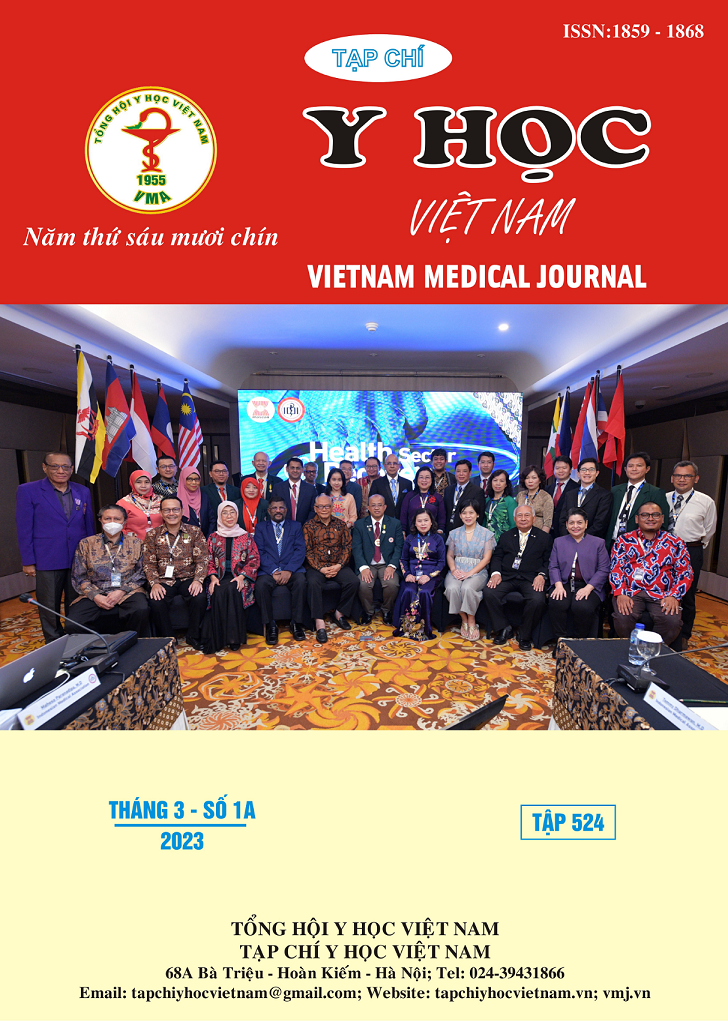CLINICAL CHARACTERISTICS OF TINEA CORPORIS AT THE NATIONAL HOSPITAL OF DERMATOLOGY AND VENEREOLOGY
Main Article Content
Abstract
Objective: To describe clinical features of tinea corporis at National hospital of Dermatology and Venereology. Subjects and methods: A cross-sectional descriptive study was performed on 182 patients diagnosed with tinea corporis at the National Hospital of Dermatology and Venereology from July 2021 to July 2022. Results: Among the subjects, males accounted for 51,7% and females accounted for 48,4%. The mean age of patients was 35.8±17.0. The most common clinical form was the tinea imbricata (89.0%). The disease duration was mainly less than 6 months (89.0%). The most common site of tinea corporis was the lower extremities (48.4%), then the abdomen (33.0%), back (28.6%), upper limb (24.2%), chest (18.7%) and neck (11.5%). Patients mainly have from 2-5 lesions accounting for 61.0%. Most patient had total lesion area less than 5% of the skin area (88.0%). All lesions had redness (100.0%). Almost lesions were scaly (93.9%), well demarcated (92.9% and central healing was seen in 89.6% of patients. Vesicular (18.1%), pustules (12.1%) and exudate (11.0%) lesions were less common. Almost lesions were itchy (97.8%). Conclusion: Tinea corporis usually presents with typical tinea imbricata with red, scaly, well-demarcated, central healing, and pruritic lesions. The lower extremities are the most common site of injury.
Article Details
Keywords
tinea imbricata, direct fungal examination
References
2. Vũ Văn Tiến (2015), “Đặc điểm lâm sàng bệnh nhân mắc nấm da khám và điều trị tại bệnh viện 103 (2013 – 2014), Báo cáo khoa học toàn văn, hội nghị ký sinh trùng toàn quốc lần thứ 42, NXB. Khoa học tự nhiên và công nghệ, tr.180 – 186
3. Tôn Nữ Phương Anh, Ngô Thị Minh Châu, Nguyễn Thị Hóa, Nguyễn Phước Vinh, Hà Thị Ngọc Thúy. Nghiên cứu tình hình bệnh nấm ở da của các bệnh nhân đến xét nghiệm tại khoa ký sinh trùng bệnh viện trường đại học y dược Huế. Phòng chống sốt rét và các bệnh ký sinh trùng. 2012;4:59-71
4. Phạm Thị Thu Hà (2019), Xác định các chủng nấm và hiệu quả điều trị bệnh nấm thân bằng uống itraconazole, Luận văn chuyên khoa cấp 2, Đại học Y Hà Nội, Hà Nội
5. Nguyễn Thái Dũng, Lê Trần Anh, Nguyễn Khắc Lực (2017). Nghiên cứu một số đặc điểm và kết quả điều trị nấm da ở bệnh nhân đến khám và điều trị tại trung tâm chống Phong-Da liễu Nghệ An 2015-2016. Tạp chí Y Dược học Quân sự, 2:118-125
6. Đoàn Văn Hùng. Tình hình, đặc điểm lâm sàng, cận lâm sàng và kết quả điều trị nấm da bằng Ketoconazole (Nizoral) tại Viện da liễu (10/2001 - 9/2002). Luận văn Thạc sĩ Y học, Đại học Y Hà Nội; 2002
7. Phạm Văn Tuấn (2019), So sánh kết quả điều trị của Itraconazole với Griseofulvin trong bệnh nấm da thân tại Bệnh viện Da liễu Bắc Ninh, Luận văn chuyên khoa cấp 2, Đại học Y dược Thái Nguyên, Thái Nguyên


